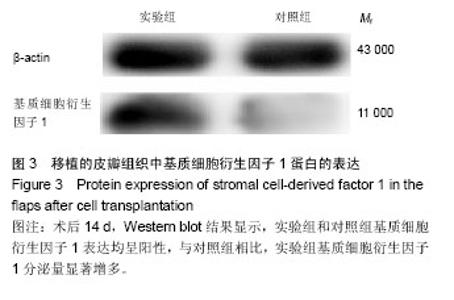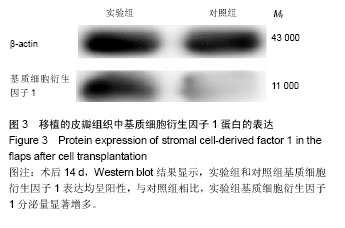Chinese Journal of Tissue Engineering Research ›› 2014, Vol. 18 ›› Issue (19): 2993-2998.doi: 10.3969/j.issn.2095-4344.2014.19.007
Previous Articles Next Articles
Human adipose-derived stem cells promote angiogenic capability of random pattern flaps in mice
Cao Jing, Jiang Nan, Xu Yang-yang, Zhu Meng-lin, Yang Liu
- Department of Plastic and Cosmetic Surgery, Fifth Affiliated Hospital of Zhengzhou University, Zhengzhou 450052, Chin
-
Revised:2014-03-01Online:2014-05-07Published:2014-05-07 -
Contact:Jiang Nan, Professor, Master’s supervisor, Department of Plastic and Cosmetic Surgery, Fifth Affiliated Hospital of Zhengzhou University, Zhengzhou 450052, China -
About author:Cao Jing, Studying for master’s degree, Department of Plastic and Cosmetic Surgery, Fifth Affiliated Hospital of Zhengzhou University, Zhengzhou 450052, China
CLC Number:
Cite this article
Cao Jing, Jiang Nan, Xu Yang-yang, Zhu Meng-lin, Yang Liu. Human adipose-derived stem cells promote angiogenic capability of random pattern flaps in mice[J]. Chinese Journal of Tissue Engineering Research, 2014, 18(19): 2993-2998.
share this article
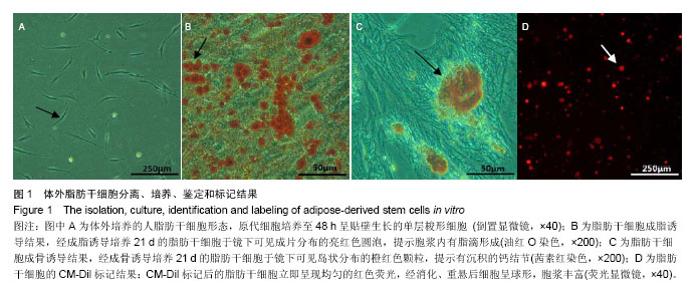
2.1 实验动物数量分析 小鼠30只均进入结果分析,无脱落。 2.2 体外脂肪干细胞分离、培养、鉴定和标记结果:提取的脂肪干细胞培养至48 h绝大部分细胞贴壁生长,呈梭形成纤维细胞样,单层分布,均匀有序,见图1A。 流式细胞学检查显示,第3代脂肪干细胞表面抗原表达比例分别为CD105(93.30±1.24)%,CD90(97.25±2.33)%,CD31(0.20±0.04)%,CD34(3.82±0.86)%,CD45(3.12± 0.53)%,HLA-DR(0.81±0.09)%,同型对照均为阴性,说明本实验分离、培养所得到的细胞阳性表达多向分化潜能干细胞的标记CD105、CD90、不表达造血系统及内皮系统抗原标记CD31,CD34,CD45,不表达成纤维细胞抗原标记CD45、HLA-DR,与以往研究结果基本吻合[18]。 成脂诱导21 d后的脂肪干细胞经油红O染色,细胞内可见成片分布的亮红色圆泡,提示胞浆内有脂滴形成,见图1B。 成骨诱导21 d后的脂肪干细胞经茜素红染色,可见岛状分布的橙红色颗粒,提示有沉积的钙结节,见图1C。 CM-DiI标记后即刻观察,在荧光显微镜下见标记后的脂肪干细胞均显红色荧光,经消化、重悬后细胞呈球形,胞浆丰富,活性良好,CM-Dil标记阳性率大于90%,见图1D。"
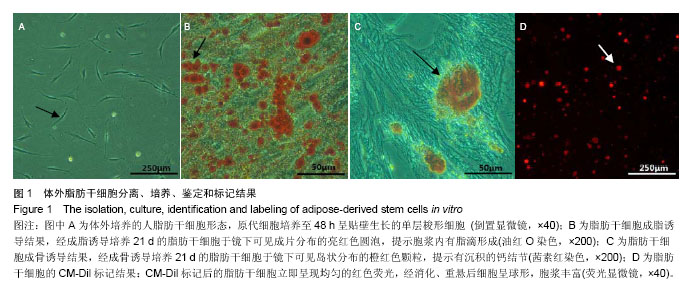
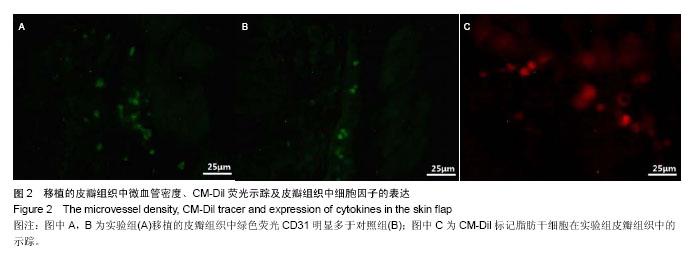
2.3 皮瓣成活率比较情况 建模后7 d,成活皮瓣与坏死皮瓣间分界清晰,易被双盲观察者区别。实验组皮瓣成活面积为(3.78±0.16) cm2,成活率为(84.0±3.6)%;对照组皮瓣成活面积为(2.27±0.16) cm2,成活率为(72.2±3.4)%;两组皮瓣成活率比较,差异有显著性意义(P < 0.05)。 2.4 皮瓣组织中微血管密度的检测和CM-Dil荧光示踪 术后14 d,和对照组相比,实验组成活皮瓣内微血管的密度有明显的增加,对照组为每200倍镜下视野内(12.8±3.11)个,实验组为每200倍镜下视野内(32.2±2.59)个,两组比较,差异有显著性意义(P < 0.05)。实验组镜下可见少量红色荧光细胞分布于皮肤组织和皮下组织深层内,但未观察到典型的红色荧光与绿色荧光重叠现象,见图2,3。 2.5 皮瓣组织中细胞因子的表达 ELISA检测显示,实验组和对照组的皮瓣组织中均含有血管内皮生长因子,实验组血管内皮生长因子水平为(687.01±19.15) μg/L,对照组血管内皮生长因子水平为(453.60±26.37) μg/L,与对照组相比,实验组血管内皮生长因子分泌量显著增多(P < 0.05)。Western blot结果显示,实验组和对照组基质细胞衍生因子1表达均呈阳性,见图2。Image J软件对条带吸光度值的分析表明,实验组基质细胞衍生因子1蛋白与β-actin吸光度值的比值为0.78±0.04,对照组基质细胞衍生因子1蛋白与β-actin的比值为0.30±0.04,实验组基质细胞衍生因子1蛋白表达水平明显高于对照组(P < 0.05)。"
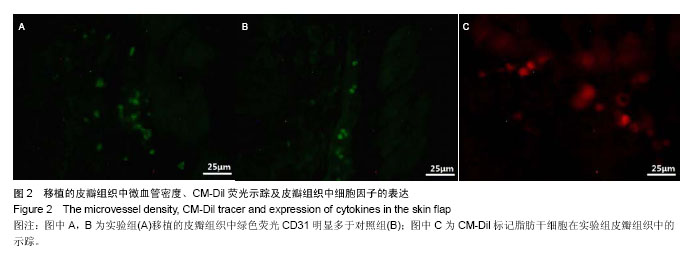
| [1] Friedenstein A, Petrakova K, Kurolesova A, et al. Heterotopic of bone marrow. Analysis of precursor cells for osteogenic and hematopoietic tissues. Transplantation. 1968;6(2):230-247. [2] Kestendjieva S, Kyurkchiev D, Tsvetkova G, et al. Characterization of mesenchymal stem cells isolated from the human umbilical cord. Cell Biol Int. 2008;32(7):724-32. [3] Danisovic L, Varga I, Polak S, et al. Comparison of in vitro chondrogenic potential of human mesenchymal stem cells derived from bone marrow and adipose tissue. Gen Physiol Biophys. 2009;28(1):56-62. [4] Bieback K, Kern S, Kocaömer A, et al. Comparing mesenchymal stromal cells from different human tissues: bone marrow, adipose tissue and umbilical cord blood. Biomed Mater Eng. 2008;18:71-76. [5] Li TS, Cheng K, Malliaras K, et al. Direct comparison of different stem cell types and subpopulations reveals superior paracrine potency and myocardial repair efficacy with cardiosphere-derived cells. J Am Coll Cardiol. 2012;59(10): 942-953. [6] Zhu Y, Liu T, Song K, et al. Adipose-derived stem cell: a better stem cell than BMSC. Cell Biochem Funct. 2008;26(6): 664-675. [7] Traktuev DO, Prater DN, Merfeld-Clauss S, et al. Robust functional vascular network formation in vivo by cooperation of adipose progenitor and endothelial cells. Circ Res. 2009; 104(12):1410-1420. [8] Nakagami H, Maeda K, Morishita R, et al. Novel autologous cell therapy in ischemic limb disease through growth factor secretion by cultured adipose tissue–derived stromal cells. Arterioscler Thromb Vasc Biol. 2005;25(12):2542-2547. [9] Bao C, Guo J, Lin G, et al. TNFR gene-modified mesenchymal stem cells attenuate inflammation and cardiac dysfunction following MI. Scand Cardiovasc J. 2008; 42(1): 56-62. [10] 杨波,沈宏亮,徐志飞,等.脂肪组织来源干细胞可促进脂肪移植物的存活率[J].中国组织工程研究,2012,16(19):3492-3495. [11] State Council of the People's Republic of China. Administrative Regulations on Medical Institution. 1994-09-01. [12] The Ministry of Science and Technology of the People’s Republic of China. Guidance Suggestions for the Care and Use of Laboratory Animals. 2006-09-30. [13] Zuk PA, Zhu M, Mizuno H, et al. Multilineage cells from human adipose tissue: implications for cell-based therapies. Tissue Eng. 2001;7(2):211-228. [14] Zuk P A, Zhu M, Ashjian P, et al. Human adipose tissue is a source of multipotent stem cells. Mol Biol Cell. 2002;13(12): 4279-4295. [15] 徐扬阳,姜南,杨柳,等.重组人碱性成纤维细胞生长因子对人脂肪干细胞分化为脂肪细胞的影响[J].中华医学美学美容杂志,2013, 19(2):134-137. [16] Pittenger MF, Mackay AM, Beck SC, et al. Multilineage potential of adult human mesenchymal stem cells. Science. 1999;284(5411):143-147. [17] Weir C, Morel-Kopp M C, Gill A, et al. Mesenchymal stem cells: isolation, characterisation and in vivo fluorescent dye tracking. Heart Lung Circ. 2008;17(5):395-403. [18] Gronthos S, Franklin DM, Leddy HA, et al. Surface protein characterization of human adipose tissue-derived stromal cells. J Cell Physiol. 2001;189(1):54-63. [19] Semenza GL. Vasculogenesis, angiogenesis, and arteriogenesis: mechanisms of blood vessel formation and remodeling. J Cell Biochem. 2007;102(4):840-847. [20] Asahara T, Murohara T, Sullivan A, et al. Isolation of putative progenitor endothelial cells for angiogenesis. Science. 1997; 275(5302):964-966. [21] Murohara T. Autologous adipose tissue as a new source of progenitor cells for therapeutic angiogenesis. J Cardiol. 2009; 53(2):155-163. [22] Traktuev DO, Merfeld-Clauss S, Li J, et al. A population of multipotent CD34-positive adipose stromal cells share pericyte and mesenchymal surface markers, reside in a periendothelial location, and stabilize endothelial networks. Circ Res. 2008;102(1):77-85. [23] Moon KM, Park YH, Lee JS, et al. The effect of secretory factors of adipose-derived stem cells on human keratinocytes. Int J Mol Sci. 2012;13(1):1239-1257. [24] Jung H, Kim H H, Lee D H, et al. Transforming growth factor-beta 1 in adipose derived stem cells conditioned medium is a dominant paracrine mediator determines hyaluronic acid and collagen expression profile. Cytotechnology. 2011;63(1):57-66. [25] Kinnaird T, Stabile E, Burnett MS, et al. Marrow-derived stromal cells express genes encoding a broad spectrum of arteriogenic cytokines and promote in vitro and in vivo arteriogenesis through paracrine mechanisms. Circ Res. 2004;94(5):678-685. [26] Deveza L, Choi J, Imanbayev G, et al. Paracrine release from nonviral engineered adipose-derived stem cells promotes endothelial cell survival and migration in vitro. Stem Cells Dev. 2012;22(3):483-491. [27] Cheng X, Wang Z, Yang J, et al. Acidic fibroblast growth factor delivered intranasally induces neurogenesis and angiogenesis in rats after ischemic stroke. Neurol Res. 2011; 33(7):675-680. [28] Li Q, Zhang A, Tao C, et al. The role of SDF-1-CXCR4/ CXCR7 axis in biological behaviors of adipose tissue-derived mesenchymal stem cells in vitro. Biochem Biophys Res Commun. 2013;441(3):675-680. [29] Di Rocco G, Gentile A, Antonini A, et al. Enhanced healing of diabetic wounds by topical administration of adipose tissue-derived stromal cells overexpressing stromal-derived factor-1: biodistribution and engraftment analysis by bioluminescent imaging. Stem Cells Int. 2010;2011:304562. [30] Petit I, Jin D, Rafii S. The SDF-1–CXCR4 signaling pathway: a molecular hub modulating neo-angiogenesis. Trends Immunol. 2007;28(7):299-307. |
| [1] | Pu Rui, Chen Ziyang, Yuan Lingyan. Characteristics and effects of exosomes from different cell sources in cardioprotection [J]. Chinese Journal of Tissue Engineering Research, 2021, 25(在线): 1-. |
| [2] | Lin Qingfan, Xie Yixin, Chen Wanqing, Ye Zhenzhong, Chen Youfang. Human placenta-derived mesenchymal stem cell conditioned medium can upregulate BeWo cell viability and zonula occludens expression under hypoxia [J]. Chinese Journal of Tissue Engineering Research, 2021, 25(在线): 4970-4975. |
| [3] | Zhang Xiumei, Zhai Yunkai, Zhao Jie, Zhao Meng. Research hotspots of organoid models in recent 10 years: a search in domestic and foreign databases [J]. Chinese Journal of Tissue Engineering Research, 2021, 25(8): 1249-1255. |
| [4] | Hou Jingying, Yu Menglei, Guo Tianzhu, Long Huibao, Wu Hao. Hypoxia preconditioning promotes bone marrow mesenchymal stem cells survival and vascularization through the activation of HIF-1α/MALAT1/VEGFA pathway [J]. Chinese Journal of Tissue Engineering Research, 2021, 25(7): 985-990. |
| [5] | Shi Yangyang, Qin Yingfei, Wu Fuling, He Xiao, Zhang Xuejing. Pretreatment of placental mesenchymal stem cells to prevent bronchiolitis in mice [J]. Chinese Journal of Tissue Engineering Research, 2021, 25(7): 991-995. |
| [6] | Liang Xueqi, Guo Lijiao, Chen Hejie, Wu Jie, Sun Yaqi, Xing Zhikun, Zou Hailiang, Chen Xueling, Wu Xiangwei. Alveolar echinococcosis protoscolices inhibits the differentiation of bone marrow mesenchymal stem cells into fibroblasts [J]. Chinese Journal of Tissue Engineering Research, 2021, 25(7): 996-1001. |
| [7] | Fan Quanbao, Luo Huina, Wang Bingyun, Chen Shengfeng, Cui Lianxu, Jiang Wenkang, Zhao Mingming, Wang Jingjing, Luo Dongzhang, Chen Zhisheng, Bai Yinshan, Liu Canying, Zhang Hui. Biological characteristics of canine adipose-derived mesenchymal stem cells cultured in hypoxia [J]. Chinese Journal of Tissue Engineering Research, 2021, 25(7): 1002-1007. |
| [8] | Geng Yao, Yin Zhiliang, Li Xingping, Xiao Dongqin, Hou Weiguang. Role of hsa-miRNA-223-3p in regulating osteogenic differentiation of human bone marrow mesenchymal stem cells [J]. Chinese Journal of Tissue Engineering Research, 2021, 25(7): 1008-1013. |
| [9] | Lun Zhigang, Jin Jing, Wang Tianyan, Li Aimin. Effect of peroxiredoxin 6 on proliferation and differentiation of bone marrow mesenchymal stem cells into neural lineage in vitro [J]. Chinese Journal of Tissue Engineering Research, 2021, 25(7): 1014-1018. |
| [10] | Zhu Xuefen, Huang Cheng, Ding Jian, Dai Yongping, Liu Yuanbing, Le Lixiang, Wang Liangliang, Yang Jiandong. Mechanism of bone marrow mesenchymal stem cells differentiation into functional neurons induced by glial cell line derived neurotrophic factor [J]. Chinese Journal of Tissue Engineering Research, 2021, 25(7): 1019-1025. |
| [11] | Duan Liyun, Cao Xiaocang. Human placenta mesenchymal stem cells-derived extracellular vesicles regulate collagen deposition in intestinal mucosa of mice with colitis [J]. Chinese Journal of Tissue Engineering Research, 2021, 25(7): 1026-1031. |
| [12] | Pei Lili, Sun Guicai, Wang Di. Salvianolic acid B inhibits oxidative damage of bone marrow mesenchymal stem cells and promotes differentiation into cardiomyocytes [J]. Chinese Journal of Tissue Engineering Research, 2021, 25(7): 1032-1036. |
| [13] | Guan Qian, Luan Zuo, Ye Dou, Yang Yinxiang, Wang Zhaoyan, Wang Qian, Yao Ruiqin. Morphological changes in human oligodendrocyte progenitor cells during passage [J]. Chinese Journal of Tissue Engineering Research, 2021, 25(7): 1045-1049. |
| [14] | Wang Zhengdong, Huang Na, Chen Jingxian, Zheng Zuobing, Hu Xinyu, Li Mei, Su Xiao, Su Xuesen, Yan Nan. Inhibitory effects of sodium butyrate on microglial activation and expression of inflammatory factors induced by fluorosis [J]. Chinese Journal of Tissue Engineering Research, 2021, 25(7): 1075-1080. |
| [15] | Wang Xianyao, Guan Yalin, Liu Zhongshan. Strategies for improving the therapeutic efficacy of mesenchymal stem cells in the treatment of nonhealing wounds [J]. Chinese Journal of Tissue Engineering Research, 2021, 25(7): 1081-1087. |
| Viewed | ||||||
|
Full text |
|
|||||
|
Abstract |
|
|||||
